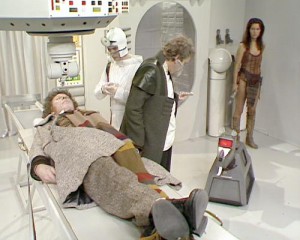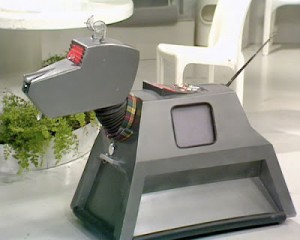 Oh dear, that wasn’t very good at all, was it? An unbroken winning streak that’s lasted for three seasons comes to a sudden halt in a parade of bad special effects, bad costumes, and narrative silliness.
Oh dear, that wasn’t very good at all, was it? An unbroken winning streak that’s lasted for three seasons comes to a sudden halt in a parade of bad special effects, bad costumes, and narrative silliness.
The story could have had potential. Writers Bob Baker and Dave Martin had come across a story about how some parasites and disease organisms alter the behavior of their hosts in order to spread themselves: such as parasites of insects and snails that cause their hosts to deliberately expose themselves to bird predators so that the bird will pick up the parasite, or the rabies virus that causes aggression in order to make the infected animal bite other animals and so spread the disease. Giving this phenomenon a Dr Who twist, we get an “Invasion of the Body Snatchers” type of story with a virus that takes over the minds of those it infects, turning them into a kind of zombie army dedicated to spreading the virus further. The Doctor himself is infected by the “Nucleus,” the leader of this microscopic alien conqueror, and finds himself struggling to retain control of his own mind.
That sounds like a brilliant and gripping idea for a Dr Who story, one which would fit right in with the Gothic Horror and Monster Movie tributes of the series’ recent era. But with all the horror and scariness downplayed in favor of a lighter tone, it just doesn’t work. It would be better if new producer Graham Williams simply jettisoned this script in favor of a story idea designed around the new style, rather than carrying on with a story that needed the old style in order to work. (I’m only assuming here that this story was commissioned by Hinchcliffe & Holmes — I don’t recall specific information about that from interviews I’ve seen — but Robert Holmes is still credited as script editor, so it’s likely.)
Specific issues:
Last week I briefly chastised fans who expected accurate science when the Doctor turned a lighthouse into an energy weapon to destroy an alien spacecraft. Dr Who does not belong on the hard SF side of the scale. But there are limits. The bulk of episode 3 of this story centers around a “Fantastic Voyage” sequence in which clones of the Doctor and Leela are miniaturized and injected into the real Doctor’s brain to find and destroy the invading virus, and the whole sequence has so much nonsense in it that it leaves suspension of disbelief whimpering in the corner saying “No more, no more.” I won’t go into specifics. Just watch it and try not to pass out.
The virus eventually gets itself enlarged to human size using the device that miniaturized the clones. It regards this as a triumph. “No longer confined to the micro universe, helpless prey to all, my offspring will now be an invincible army sweeping across the universe!” Really? It was more menacing when it was infecting human beings and taking over their minds. Now it can’t even move without its minions dragging it around, and it looks like someone dressed up as a shrimp for Halloween.
Special effects failures plague the episode throughout. This is always Classic-Who’s problem, of course, but at its best the producers and directors have known how to craft stories that operate within the series’ budgetary limitations. But now, Graham Williams wants to replace horror with lighter sci-fi, so he encourages the writers to fill up the story with space shuttles and meteor storms and space bases on Titan and hospitals built into asteroids. All of these effects are front-and-center in the story, and all realized with small plastic models swinging back and forth on strings. (Contrast, to take one example, “The Ark in Space” from a few seasons back– the space station and rocket launch scenes are just as low budget, but the story is written to make the need for them as small as possible.)
The bottom line of all this perhaps comes from the DVD commentary tracks by those who worked on the stories. Over the past 3 seasons of stories, the comments have been along the lines of, “I’m really amazed at how well this holds up, considering our budget and that it was 35 years ago.” For this story, all of a sudden, the comments are, “Oh, well, the kids liked it.”
That kind of says it all.
The Bright Spot
 Look who’s here! The redeeming feature of this story is the addition of K-9 to the TARDIS crew. The head of the space hospital where most of the story takes place, Professor Marius, has built himself a mobile computer assistant with onboard chemical/medical analysis functions, a massive database of information, and a voice-activated, interactive operating system.
Look who’s here! The redeeming feature of this story is the addition of K-9 to the TARDIS crew. The head of the space hospital where most of the story takes place, Professor Marius, has built himself a mobile computer assistant with onboard chemical/medical analysis functions, a massive database of information, and a voice-activated, interactive operating system.
And, because he always had a pet dog back home but couldn’t bring it with him into space, he built it in the shape of a dog and called it K-9.
K-9 is a great character right from the start. The writers wisely avoided having him just bark or beep. He talks, and he’s got a fun, well-drawn personality. He has the loyalty of the born sidekick, like any good dog, but adds to it a sort of ironic or sarcastic humor that keeps him from becoming bland. “K-9 knows everything I know,” Marius declares proudly, “don’t you, K-9?” “Affirmative, Master,” K-9 happily replies, then adds, “And more.”
At the end of the story, Marius asks the Doctor to take care of K-9, since he’s returning to Earth and the weight allowance won’t allow him to take K-9 back with him. K-9 happily trundles aboard the TARDIS, and will remain a part of the Dr Who universe all the way to the end of the modern Sarah Jane Smith Adventures.
Side Note: The DVD for “The Invisible Enemy” also includes “K-9 and Company,” the pilot episode for the first proposed spinoff from Dr Who. The story is canonical for Dr Who, since it shows how Sarah got K-9 and she still has him when she appears again in the main series, but I’ll save comment on it until I get to the time when it actually aired.
Details
- Graham Williams is, by and large, the least well-regarded producer Classic Dr Who ever had. He has his defenders, but there isn’t the nearly the debate that there is over his polarizing successor John Nathan-Turner. During Williams tenure, Dr Who dialed way back on scariness and emphasized humor in its place. Tom Baker readily exaggerated his eccentric version of the Doctor to fit the new style, with the result that fans generally view this era of the show as turning into a sitcom, “The Tom Baker Show.” There’s room for debate over whether the failures of his era were really Graham Williams’ fault: he came in with a politically-fueled mandate from the BBC to make the changes that he made, and there is some reason to think, from things others report him as saying, that he would have liked to do things differently (he died in 1990, so wasn’t around by the time Doctor Who Magazine began to really dig into the history of the series for lack of new episodes to discuss, so we don’t really have any of his own comments on his era to go by).
- Leela, as a character, suffers a severe downgrade in this episode. She’s given no opportunity at all to show her intelligence, and the best that can be said is at least she isn’t made to do or say anything specifically stupid. She’s allowed to have an instinctive sense of danger which proves accurate– but then she’s made to react to that sense fearfully, rather than aggressively as she would have before. The worst moment comes when the Doctor and Marius are discussing Leela’s immunity to the virus. The virus, we’ve learned, feeds on intelligence. The Doctor suggests that’s why Leela is immune. It does eventually turn out she’s immune because of an antibody in her blood, but the fact that the Doctor would even suggest that tells you what the writers think of Leela.
- Although K-9’s a great character, as a prop he’ll prove an ongoing nightmare for the production crew. Although they do their best to make out that K-9, futuristic machine, can move around outdoors as well as in, and hover up over steps or door jambs, the actual prop could do none of those things and very convoluted writing or staging will often be needed to cover the props limits. Often, he’ll just be left out of stories altogether, with some brief remark about why he’s stuck inside the TARDIS for a given adventure.
Next Week:
“Image of the Fendahl” 4 episodes, and a lot better than this week’s story.

